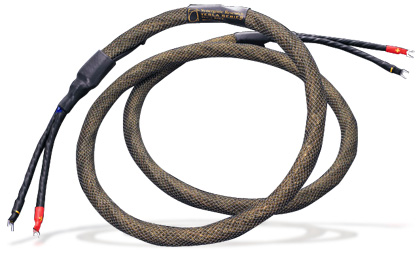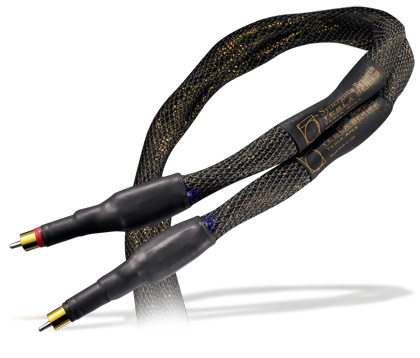| November 15, 2009
Synergistic Research Tesla Apex Interconnects and
Speaker Cables

| Associated Equipment Loudspeakers -- Acapella LaCampanella
Digital sources -- Exemplar/Shanling SCD-3000
SACD player, Exemplar music server, Exemplar/Xindak XD-1 DAC
Preamplifier -- H-Cat P-12R X8D
Power amplifiers -- H-Cat DF-100.2, LSA
Statement (only amp stage used)
Digital cable -- Stealth Audio Varidig Sextet
Interconnect -- Jade Audio Vermeil and Hybrid,
Townshend Audio DCT300
Speaker cable -- Jade Audio Vermeil
Power cords -- Synergistic Research Hologram D
(2), Hologram A, and Tesla T2 (3)
Power conditioner -- Synergistic Research
PowerCell 10 SE |
|
|
|
My system includes Synergistic Research’s Acoustic ART
room-tuning system, PowerCell power conditioner, and several Tesla power cords. At the end
of my very positive experiences with these components, Ted Denney of Synergistic Research
asked me to add sets of their Tesla Apex charged interconnects and speaker cables to my
system. Once I’d heard a complete cable system fully shielded from DC current, he
said, I wouldn’t tolerate anything else. I took him up on his challenge.
After we’d discussed my system and needs, Denney sent
me an 8’ pair of Tesla Apex speaker cables ($6500 USD) and two 1m pairs of Apex
interconnects ($3600/1m pair). He also sent along a 1m pair of Precision Reference
interconnects to connect my line stage to my power amp, as well as a 1m Tesla D3 digital
cable.
Like the Synergistic Research power cables in my system,
the new Tesla Apexes include what Synergistic calls Zero Capacitance Active Shielding
circuitry, which puts a direct-current charge on the shield at zero capacitance to prevent
interference from external radio and other electromagnetic signals.
Description
One thing you have to tolerate with Synergistic Research
cables is that you end up with many more wires than you think you will. Because the
company believes in charged shielding, each cable has a power charger, and a blue LED that
lets you know that everything’s hooked up properly. When you turn off your
listening-room lights at night, the LEDs’ blue glow about equals that of a bright
full moon -- no need for nightlights. Of course, this was with seven power cords, four
sets of interconnects, and a pair of speaker cables.
Synergistic’s entire Tesla line of interconnects and
speaker cables combines three technologies -- Tesla Tricon cable geometry, Zero
Capacitance Active Shielding, and a conditioning process called Quantum Tunneling (patent
pending) -- all purportedly based on the work of Nikola Tesla. Quantum Tunneling involves
sending through the cables 2 million volts at a specific pulse modulation ultrahigh
frequency for a certain amount of time -- and, obviously, at quite low amperage. This
process reportedly derives from Tesla’s experiments with the Tesla coil.
As Ted Denney says about the cable designs:
What I found was a radical concept that suggested a cable
could be designed that would function as an electromagnetic "lens" to
concentrate fluctuating alternating current and its subsequent electromagnetic fields for
perfect transfer without distortion or loss of signal. Just as a lens focuses light by
concentrating or dispersing rays of light, this new geometry, if it could be developed,
would concentrate and focus the sonic signal not by separating conductors, but by
strategically aligning conductors in a symmetrical geometry that manages electromagnetic
fields as a lens precisely focuses light.
Success in developing these ideas led to the Tesla
Tricon(ductor) Lens formula. The Tesla series combines this geometry in carefully
considered combinations with two older Synergistic Research geometries. These are the
Tesla Vortex and the Tesla Acoustic. Understandably, the exact configurations of these
geometries are not revealed. Each, however, is a full cable with hot, neutral, and shield,
and they are used in different combinations. For example, the Precision Reference
interconnect uses just two Tesla Tricons for the fastest transfer rate between the line
stage and the amp. The Apex interconnects uses two Tricons and two Acoustics.
The Apex cabling uses pure monocrystal silver wire in the
special conductor geometries with the Zero Capacitance Active Shielding and the Quantum
Tunneling conditioning process. This is true of both the Apex interconnects and speaker
cables.
Setup
I introduced the Tesla Apex cables into my system one at a
time, beginning with the speaker cables. I did this to see whether one cable would provide
an improvement. I can’t say I noticed any such thing, but as I added cables, the
quietness of their shielding became increasingly evident, as did their great extension of
my system’s top and bottom ends. These cables were ruthlessly neutral. I had to
adjust the Wave Timing Control, a proprietary circuit in my H-Cat preamp that lets the
user focus the soundstage to get the most vivid and precise images. The WTC was at a
setting quite different from any I’ve used with either my Jade or Townshend reference
cables. And despite the Active Shielding, the Synergistic cables benefited from isolation
from vibrations and static electricity, which I provided with Harmonix A1 cable supports
and Rightway Audio Ceramic Suspenders under the speaker cables (but only Suspenders under
the interconnects).
At first, there was minimal improvement in the cables’
sound with break-in; after the first three days, I noticed no further changes. However,
better than two weeks into my evaluation, there was a substantial and sudden jump in
transparency.
Listening
As is my practice at the Consumer Electronics Show, T.H.E.
Show, RMAF, and at home, one of the discs I use to evaluate systems is This Is K2
HD Sound! (CD, First Impression Music FIMK2HD078), fed to my home system from the hard
drive of my Exemplar Music Server. In track 1, Rachmaninoff’s Symphonic Dances,
from Reference Recordings, the orchestra is vividly placed in a panorama before you as it
plays several stupendous crescendos. With the Tesla Apex cables installed, the climaxes of
these crescendos were thunderous, directional, and quite deep. Also, individual
instruments within the orchestra were now quite evident, even when I turned the volume
down. The bass was full of energy that hit me viscerally, and the instrument creating
these bass notes was more easily located in the soundstage. The individual instruments and
vocalists stood in clearly evident locations within the recording venue. The realism was
thrilling.
I’ve heard track 2, a flamenco performance titled
Zapateado, sound quite different through different systems. Sometimes it sounds as if
the dancer is working on a hollow, poorly constructed floor, sometimes as if he’s
very heavy, sometimes as if a microphone stand is picking up vibrations from the floor,
and sometimes there is no plausible soundstage (although there’s usually some sense
of the dancer’s movements at the end of the track). I can’t say that the Tesla
Apexes totally resolved these differences. The stage sounded quite firm, and there was
some sense of feedback through the mike stands. The toe and heel taps were distinct, and
the acoustic guitar had great realism. However, I still could not quite resolve the
placement of the guitarist and the dancer over my system.
 Track 5,
"Touch," includes lightly struck bells that shimmer, and gongs with nice decay,
as well as an enormous drum that virtually explodes. The width and depth of the
soundstage, the length of the decay of the bells and gong, and the leading edges of the
drumstrokes, all vary greatly among systems. With the Synergistic Research cables in my
system, the separation, depth of image, and startling impact were unexcelled by other
cables I’ve heard. Pachelbel’s Canon in D, performed by the All Star Percussion
Ensemble (track 16), provided excellent tests of ambience, accuracy of wood and bell
timbres, and dynamic range. This recording also includes substantial nonmusical details: a
thunderstorm, people moving around as the performance continues, and traffic noise
outside. The low noise floor provided by the Synergistic cables let me hear these
background noises, as well as the subtleties of the instruments being struck and the
following decays, better than I’d ever heard before. Track 5,
"Touch," includes lightly struck bells that shimmer, and gongs with nice decay,
as well as an enormous drum that virtually explodes. The width and depth of the
soundstage, the length of the decay of the bells and gong, and the leading edges of the
drumstrokes, all vary greatly among systems. With the Synergistic Research cables in my
system, the separation, depth of image, and startling impact were unexcelled by other
cables I’ve heard. Pachelbel’s Canon in D, performed by the All Star Percussion
Ensemble (track 16), provided excellent tests of ambience, accuracy of wood and bell
timbres, and dynamic range. This recording also includes substantial nonmusical details: a
thunderstorm, people moving around as the performance continues, and traffic noise
outside. The low noise floor provided by the Synergistic cables let me hear these
background noises, as well as the subtleties of the instruments being struck and the
following decays, better than I’d ever heard before.
Three other recordings also helped. As I listened to Duke
Ellington’s The Great Paris Concert (CD, Atlantic UK B00000213G), particularly
"Kinda Dukish" and "Don’t Get Around Much Anymore," other
cables failed to lend a sense of being there; the Synergistic Research cables were
excellent, although the big band in the background still wasn’t as dynamic as it
would have been had I been present at the concert. In Frank Sinatra’s melancholy
performance of "One for My Baby," on his Only the Lonely (CD, Mobile
Fidelity Koch B001BJ65SU), the large orchestra is silent at the start, but after some time
it enters, very softly. The intimacy of the arrangement and the blues in Sinatra’s
voice were excellently conveyed through the Tesla Apexes.
In comparisons of the Synergistics with my reference Jade
Hybrid and Vermeil interconnects and speaker cables and Townshend DCT300 interconnects,
several things stood out. First, possibly because of their Active Shielding, the
Synergistics were uniquely quiet -- in fact, they’re the quietest cables I’ve
heard. Second, they were exceptionally fast; the leading edges of horns, bells, and gongs
were spot on. Third, their bass was profoundly deep and precise -- an attribute as well of
Synergistic’s power cords and PowerCell. Fourth, their reproduction of high
frequencies rang true -- I immediately noticed and rejoiced in that top end. Finally, the
soundstages thrown by the Synergistics were strikingly realistic: not only wide and deep
and, as some say, layered, but precise as well.
Conclusions
The Tesla Apexes are hardly inexpensive. They’re
labor-intensive: each of the three different construction techniques of the component
cables is done by hand. Synergistic Research has been in business now for 20 years, and
its considerable investment in the development of new technologies is evident in these
cables. Still, the Tesla Apexes cost substantially less than some cables that, to my ears,
they outperform. These are the finest interconnects and speaker cables I have heard.
. . . Norm Luttbeg
norml@ultraaudio.com
Synergistic Research Tesla Apex Interconnect
Price: $3600 USD per 1m pair.
Synergistic Research Tesla Apex Speaker Cable
Price: $6500 USD per 8’ pair.
Warranty: One year; includes lifetime upgrade value against future purchase of other
Synergistic Research cables.
Synergistic Research
17401 Armstrong Ave., Suite 102
Irvine, CA 92614
Phone: (800) 578-6489, (949) 476-0000
Website: www.synergisticresearch.com
|